We should have asked. We had noticed the young man standing by the sidewalk – not so much in the middle of the walkway, but on the edge, somewhat nonchalantly, looking around – crisp cream shirt, black trousers. He stood in front of a quiet, understated entrance whose signage we did not initially see; we also didn’t want to gawk and only glanced in its direction (we thought it could have been someone’s residence). We should have just asked, “Sumimasen, Kichisen wa, dochira desu ka?” (Excuse me, where is Kichisen, please?)
It took us an hour by Kyoto’s city bus to get to Kichisen on the other side of the city, approximately the same time estimated by Google walking directions. It’s a good thing that we left the Shunkoin Guest House with plenty of time.
Kichisen was our first truly fancy meal of the trip, selected because of Michelin, recommendations and accounts by Kyoto Foodie, and some research on Chowhound.
Making reservations is easy enough – their website now has an English interface. I submitted an online form, and subsequently received a series of emails confirming our reservation, and asking for more information – whether we wanted to sit Japanese-style or western style, and whether we had any food allergies. I requested the counter (as DD and I are wont to do), and received a response that read, “Understood. Please be advised that at the counter there could be another party.” I suppose kaiseki is usually ideally served in a private room.
They also sent some useful information regarding where they were located and suggested that we might want to wander around the Shimogamo Shrine located next to the restaurant, a UNESCO-designated World Heritage Site. Alas, we didn’t have time and actually had some difficulty in locating Kichisen, though the bus dropped us off a few yards away from the entrance – we should have studied photos of the entrance more assiduously. It was, as I had suspected, that modest entrance in front of which stood the youth.
Kichisen’s Chef Yoshimi Tanigawa is known, among other things, for being the man who beat the Iron Chef Masaharu Morimoto (on the original Japanese Iron Chef series). He also runs a beautiful restaurant.
A few days before our visit, as we were on the train from Kanazawa to Kyoto, we received an email from Kichisen letting us know that despite the Tohoku earthquake and numerous cancellations, Kyoto was fine. Would we be arriving on the 4th at 6:30pm as planned? It was so quiet when we finally found the restaurant and entered. We may have been the only customers there that evening. We took off our shoes at the genkan, and were asked immediately if we needed to use the restroom before dinner commenced. We went, one by one. A bathroom break that might ruin the flow of the kaiseki? We were the only ones at the counter, and the shoji remained closed for the duration of the meal, giving us a private room after all.
The Kaiseki:
Many items in the stores and shops at this time of year were sakura themed – at Kichisen it was no different – we started with some sakura tea, which is essentially a salted cherry blossom in a bit of hot water, possibly mixed with a drop of sake.
First course — Sakizuke: trio of small bites nestled in adorable bird ceramics – nestled within were: Tiny dried shrimp and clams with a sweet sauce that tasted reminiscent of mirin and soy; sansho flowers; small tako, or octopus, mountain yam, vinegar; caviar, fried parsnip chips, tiny shrimp.
Another saikzuke was a beautiful bowl of usui-endo, or peas, served with a light, sweet and clear consomme.
Third course — Futamono, or the lidded dish. We were instructed to lift the lid and breathe in the scent – yuzu, ume, umami dashi: Clear ichiban dashi, Hotate dumplings, large Ume, nanohana (rape), yuzunohana (yuzu petals); shikushi (some sort of bitter reed). In the bowl was the largest pickled ume we had ever seen before – it wasn’t as sour as we expected, and paired well with the Hotate scallop dumpling. The dashi was sublime, of course.
Fourth course — the Mukozuke, seasonal sashimi – one of my favourite dishes of the trip. The Japanese are famous for their compartamentalized bento boxes and beautiful, miniscule presentation and plating – if ever there was a dish that looked like a boxful of jewels, this was it. From top left, and going clockwise: ika w/ matcha gelee; Hotate scallop; Anago babies w/ sweet miso; Katsuo Boshi (bonito) w/ gyouja ninniku (Japanese ramps); Tai w/Shisho and warabi (fiddlehead fern); Maguro o-toro w/ grated daikon and ponzu. (As always, larger photos can be found on my Flickr set.)
Fifth course — Nigiri sushi: one beautiful piece of Maguro O-toro tuna belly. It was served with a fine linen cloth to wipe our fingers alongside the shoyu. Butter on the palate.
Sixth course — O-toro with negi handroll – hand-delivered to both of us by Chef. I was too busy stuffing it into my mouth to remember to take a proper photo, alas. The negi was not overpowering, but sweet and complemented the oily toro tuna very well.
7th course — Sakura Zushi and Tai skin. The staff brought out a beautiful lacquered box and lifted it to show 4 gorgeous pieces of tai nigiri wrapped in salted cherry blossom leaves. In addition, there were two small dishes of tai skin with some sort of sauce. The next morning, when we opened up the “take-away” boxes Kichisen had packed for us, we disassembled the wrapped rolls to find that a sprig of sansho had been tucked in between the fish and rice.
8th course — Hassun: the seasonal dish showcasing the latest from the sea and sky, these arrived on gorgeous sea shells lined with gold. Normally the hassun is a second course, but chef must have decided for some reason to present it here. This hassun was composed of snail, unagi, nanohana flower w/ gomae; tiny dried sweet soy fish; cucumber, an ebi square, Ume gelee, square of herring roe and nori. Cherry Blossom petals and sansho leaf also provided edible décor. It was accompanied by a tiny vessel simply called “tamago” – this container held 2 kinds of egg – quail and shirako (fish milt) dressed with dashi, sake and soy.
9th course — perhaps the Nimono, or simmered dish: Takenoko (bamboo shoots) w/ wakame, kinome (pepper tree leaf), hot dashi broth.
10th course — the Yakimono: grilled fish – here, Ayu, or sweetfish, served gorgeously in a tall basket-encased structure, and then with a tade-zu, tade herb mixed with vinegar and sake. The ayu are grilled whole, so you consume everything – head, eyes, bones, liver… pleasant bitterness enhanced with the sour tade-zu.
11th course — Gohan: Rice, pickles and O-cha. Out came an earthenware vessel that revealed a beautiful steamed pilaf topped with fish — Tai gohan – presumably made with the Sea Bream cut up for our sashimi and sushi; the pickles were a selection of salty napa cabbage, barely pickled cucumber, rare black mushroom, vinegared seaweed.
12th course — Mizumono: Seasonal dessert of Sampo Citrus Jelly, Cointreau, Ama-o Strawberry.
13th course — Wagashi and thick matcha tea. We received two kinds of wagashi — I’m not entirely sure what covered this mochi-paste, azuki-stuffed sweet; it may have been toasted soybean flour, or kinako. The other wagashi was covered with nori, which imparted a savoury taste to the dessert.
We had a great time with the staff — they spoke some English and were able to give us the names in English of the dishes above. More often than not we asked for the Japanese names of the ingredients. “Nihongo, onegai shimasu…” Chef did come out on occasion and spent quite a bit time with us after the meal, quizzing us on our trip and even asking us how much plane tickets were. Apparently we had gotten such a great deal from Korean Air (around $900 round-trip for each of us) that Tanigawa-san was in disbelief. He ended up calling a friend of his who spoke English, and, handing his mobile phone to me, asked her to verify the amounts. He also was quite enthused when he found out that DD worked for Google. DD caught the word “kabu,” in the stream of words – and it turns out that kabu could either mean turnip or company stock, which made for a funny realization.
Kichisen serves menus that range from ¥18000, ¥20000 and ¥28000, exclusive of drinks. We chose the middle option — that included 2 extra dishes of seasonal ingredients. More photos on Flickr here.
Kichisen, Kyoto | 京料理吉泉
Kyoto-shi, Sakyo-ku, Shimogamo Morimoto-cho 5
(京都市左京区下鴨糺ノ森森本町 5)
Tel: +81 75 -711-6121
Fax: +81 75-711-8993

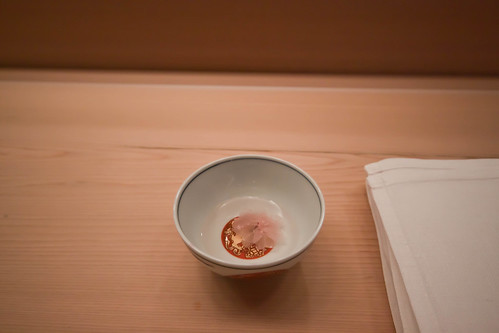

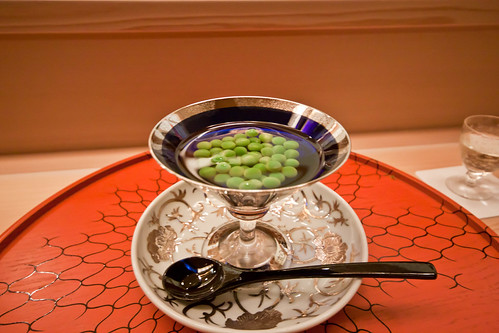
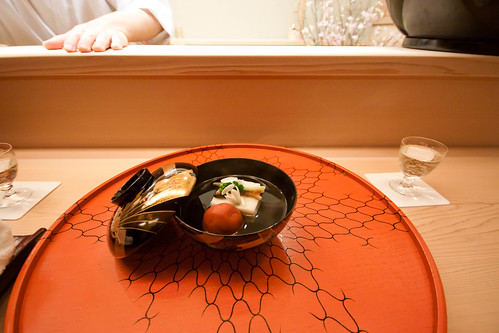
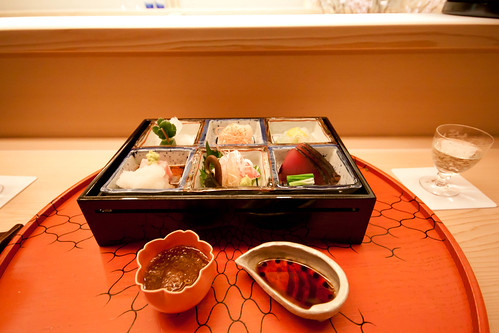
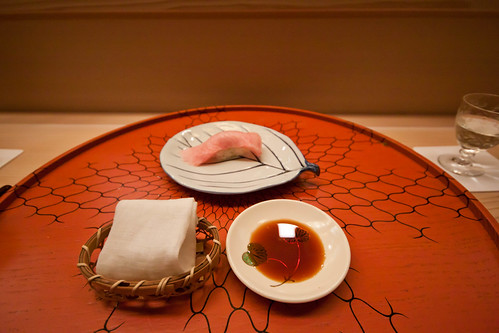
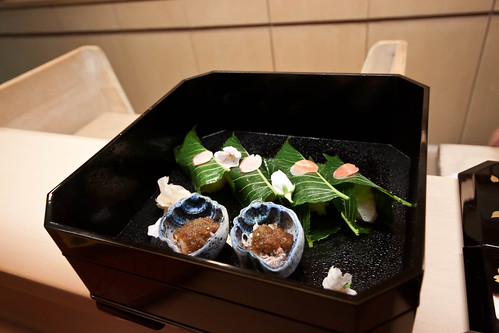
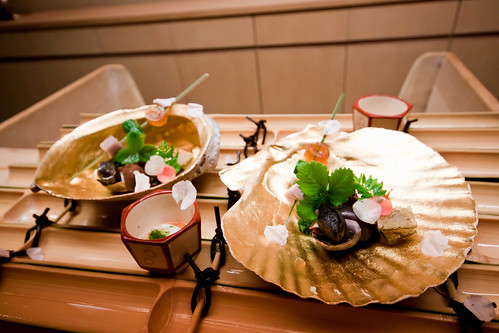

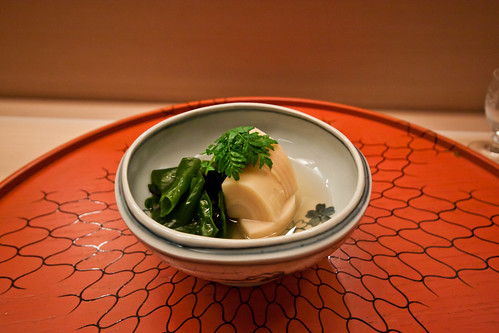
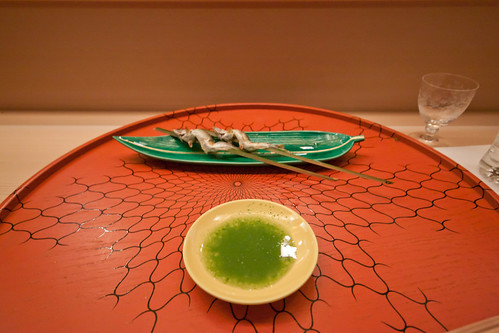
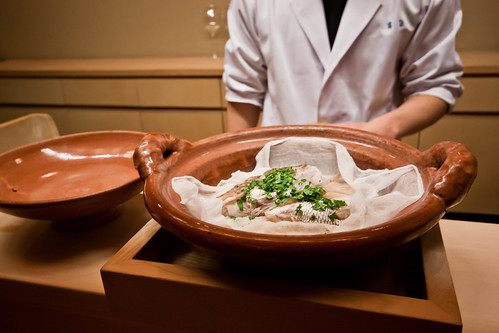
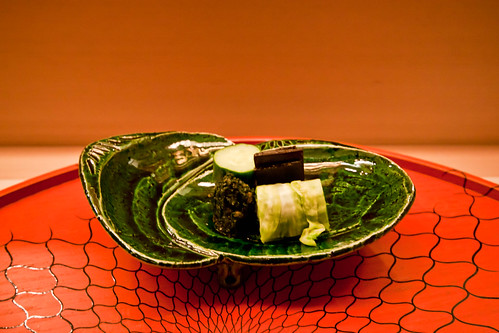

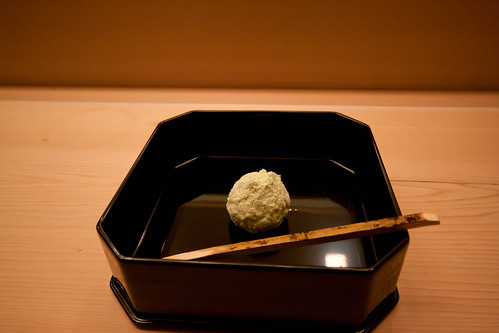

Pingback: Roan Kikunoi in Kyoto | Memory & Desire()
Pingback: Kichisen Take-Away | Memory & Desire()